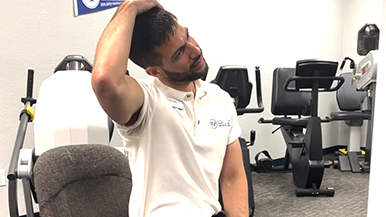 What is plantar fasciitis?
What is plantar fasciitis?- What are the symptoms of plantar fasciitis?
- What causes plantar fasciitis?
- How can I stop plantar fasciitis pain?
- How can physical therapy help with plantar fasciitis?
If you are afflicted by plantar fasciitis, you’re going to know it. It can be an extremely painful affliction causing sharp burning or stabbing pains in the bottom of your feet and heels. The pain can make normal everyday behaviors such as simply getting out of bed and walking to the bathroom a wince-inducing process.
Two million people a year are affected by this condition, and one in every 10 people will be afflicted by plantar fasciitis in their lifetimes. The most common symptom and easiest way to tell if you have it is painful feet.
How can you ease this pain? Let’s go over plantar fasciitis in more detail to help you understand more and find relief.
What Is Plantar Fasciitis?
 Plantar fasciitis is an inflammatory condition affecting the tough band of ligament that runs across the bottom of the foot from the heel to the toes just under the skin, known as the plantar fascia. The plantar fascia is part arch supporter and part shock absorber. Too much pressure on this ligament and it can swell and inflame causing sometimes the severe pain and stiffness known as plantar fasciitis.
Plantar fasciitis is an inflammatory condition affecting the tough band of ligament that runs across the bottom of the foot from the heel to the toes just under the skin, known as the plantar fascia. The plantar fascia is part arch supporter and part shock absorber. Too much pressure on this ligament and it can swell and inflame causing sometimes the severe pain and stiffness known as plantar fasciitis.
Your feet are complicated. There are 26 bones, 33 joints, 107 ligaments, and 19 muscles in each foot. This complex architecture supports the full weight of your body and the force of walking, jumping, running, and more. We require a lot of our feet and many times neglect them as the forgotten part of our bodies—that is until something painful happens, such as the development of inflammation.
What Are the Symptoms of Plantar Fasciitis?
While pain can be a broad term, there are some specific types of sensations that may indicate that the pain in your feet is caused by plantar fasciitis rather than some other form of condition or injury. The symptoms can include:
- A swollen heel
- A tightened Achilles tendon
- Bottom of the foot pain, usually centered near the heel
- Foot pain after exercising
- Pain in the foot’s arch
- Pain that goes on for months
- Pain when you step on your feet for the first time after resting
Usually, plantar fasciitis symptoms lessen after you’ve gotten out of bed in the morning. It’s that first hobbling around after staying off your feet for a while that can cause a pain flare-up. If you’re trying to live with the pain, you’ll probably hold your body differently. This can cause back, hip, and leg pain as you try to compensate for your very tender feet.
What Causes Plantar Fasciitis?
 Plantar fasciitis can come on with no obvious causes that you can discern. You may have switched shoes or pounded the pavement a little too hard on your last run. There are a few lifestyle and physical issues that make you more prone to develop this type of ligament strain:
Plantar fasciitis can come on with no obvious causes that you can discern. You may have switched shoes or pounded the pavement a little too hard on your last run. There are a few lifestyle and physical issues that make you more prone to develop this type of ligament strain:
- Being between the age of 40 and 60, when the development of this condition is most common
- Being overweight, which can add strain to the weight-bearing portions of your body such as the feet
- Having high arches or, conversely, flat feet
- Running long distances frequently
- Standing on your feet all day
- Wearing sandals or other shoes with poor foot support
If you’ve developed bottom of the foot pain, your doctor will look at your medical history and conduct a physical exam. Usually, no imaging tests are needed, but if the doctor suspects other problems, such as a stress fracture, an X-ray or MRI may be necessary.
How Can I Stop Plantar Fasciitis Pain?
Stopping plantar fasciitis pain starts with a trip to your doctor. A careful assessment and treatment will help stop the pain. Most people recover in a few months with some of the following treatments:
- Injections of steroidal medications to relieve the inflammation
- Orthotics, or custom foot supports to redistribute the pressure on your feet
- Over-the-counter pain relievers like ibuprofen or naproxen sodium
- Night splints that hold the Achilles tendon and plantar fascia in a lengthened position while you sleep
- Shock wave therapy, which uses sound waves to stimulate healing
- Surgery, but only when other treatments have failed
- Ultrasonic tissue repair, which guides a needle probe into the ligament to break up the damaged tissue and remove it with suction
- Walking supports such as a boot, crutches, or a cane
Home remedies to lessen plantar fasciitis pain include:
- Applying ice three to four times a day
- Changing your sport of choice from running to swimming, for example
- Choosing good supportive shoes
- Losing weight
- Stretching your calves, Achilles tendons, arches, and plantar fasciitis ligament
Trying to ignore a strained plantar fascia is no good; you may develop chronic heel pain or develop new ways of walking to compensate. This could in turn lead to other problems with the feet, back, hips, or knees.
How Can Physical Therapy Help With Plantar Fasciitis?
Physical therapists are experts in movement. They restore mobility through hands-on treatments designed to ease pain and strengthen the body. How can a physical therapist help ease your pain?
Typical plantar fasciitis treatments prescribed by a physical therapist include:
- Applying ice to reduce inflammation
- Assessing your gait and applying gait training to improve how you walk
- A night splint
- Orthotics for the shoe
- Taping the foot
- Teaching you stretching and strengthening exercises
 Your physical therapist not only can help treat the painful symptoms; we can teach you coping skills to ensure the problem doesn’t return. This can include:
Your physical therapist not only can help treat the painful symptoms; we can teach you coping skills to ensure the problem doesn’t return. This can include:
- Coaching you through exercises to support a healthy body weight
- Helping you find the right shoes to support your feet properly
- Recommending a thick mat to stand on if you must stand all day
- Suggesting an exercise routine that includes warmups for the feet
- Suggesting exercises for the calves and legs to support the feet
Ability Rehabilitation specializes in developing individualized treatment plans to help keep your feet and the rest of your body healthy at all the stages of your life. Talk with our team today about how we can help with your chronic foot pain.



